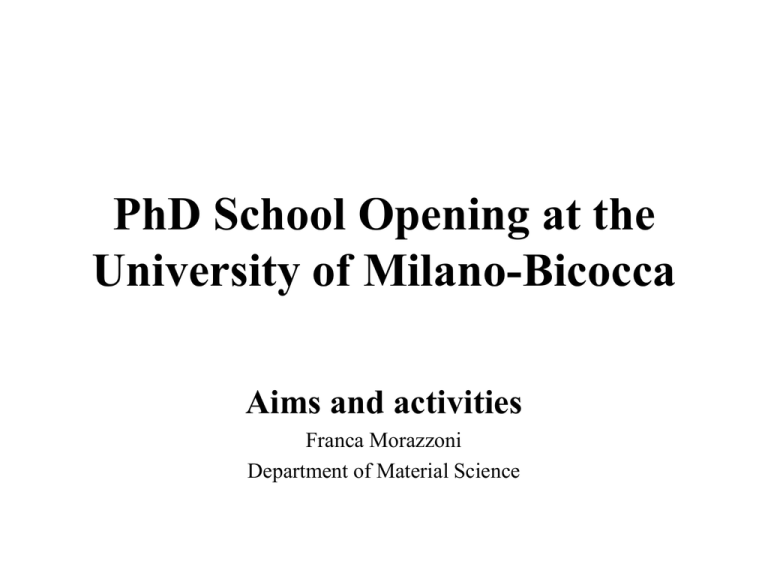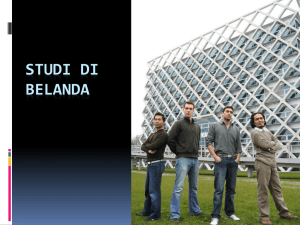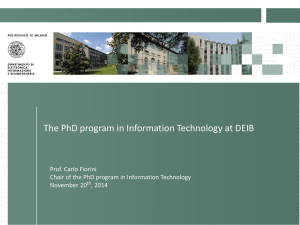PhD School of the University of Milano Bicocca
advertisement

PhD School Opening at the University of Milano-Bicocca Aims and activities Franca Morazzoni Department of Material Science MIUR guidelines for PhD activation The MIUR rules for the activation of PhD Courses aim : 1) to create a disciplinary and interdisciplinary environment 2) to offer courses at an advanced level specifically on informatics project management intellectual property technology transfer foreign languages for scholars ANVUR published the following requirements for opening a PhD Course: A 1. Adequate location of the PhD Course A 2. Adequate scientific skills A 3. Adequate tutoring in the course (quality and number) A 4. Adequate number of grants A 5. Adequate scientific structures A 6. Organization of detailed and unified training activity The courses should contribute to the development of a thesis involving as many interdisciplinary aspects as possible in order to successfully complete the research project the preparation of PhD graduates for positions in academic, public and industrial research, scientific management Comments on the first PhD Schools of MilanoBicocca The PhD School of Science, given as satisfied the quality of the governance and of the location, suggested: common enrollment criteria for all PhD courses (qualifications and interview) organized courses with required annual exams common standards for thesis compilation and defense. In the 7 PhD Schools of Milano-Bicocca there was a lack of a common core program and research format. The probable reason is that either students or tutors were unable to recognize that a common behaviour is useful for optimizing professional results and also adds value to the PhD istitution Innovation in the School of Milano-Bicocca 2014 The decision of Milano-Bicocca was to constitute a unique PhD School composed of 19 PhD courses The School will decide enrollment criteria a minimum number of cfu corresponding to organized courses in advanced and elective disciplines relative annual exams, together with scientific report on thesis activity criteria for thesis compilation and defense 2014 PhD Courses in Milano-Bicocca ANTROPOLOGIA CULTURALE E SOCIALE Prof. Ugo Fabietti ECONOMIA - DEFAP Prof.ssa Giovanna Iannantuoni FISICA E ASTRONOMIA Prof. Giuseppe Chirico INFORMATICA Prof.ssa Stefania Bandini MATEMATICA PURA ED APPLICATA Prof. Roberto Paoletti MEDICINA TRASLAZIONALE E MOLECOLARE - DIMET Prof. Andrea Biondi NEUROSCIENZE Prof. Guido Cavaletti URBEUR-QUASI, CITTA' E SOCIETA' DELL'INFORMAZIONE Prof.ssa Serena Vicari PSICOLOGIA, LINGUISTICA E NEUROSCIENZE COGNITIVE Prof.ssa Maria Teresa Guasti SANITA' PUBBLICA Prof. Guido Grassi SCIENZA E NANOTECNOLOGIA DEI MATERIALI Prof. Gianpaolo Brivio SCIENZE DELL’AMBIENTE, DELLA TERRA, SCIENZE CHIMICHE Prof. Marco Vighi SCIENZE DELLA FORMAZIONE E DELLA COMUNICAZIONE Prof.ssa Laura Formenti SCIENZE BIOLOGICHE E BIOTECNOLOGICHE Prof. Marco Vanoni SCIENZE GIURIDICHE Prof.ssa Margherita Ramajoli SOCIOLOGIA APPLICATA E METODOLOGIA DELLA RICERCA SOCIALE Prof.ssa Carmen Leccardi STATISTICA E MATEMATICA PER LA FINANZA Prof. Giorgio Vittadini PhD Grants in 2014 Bicocca Bursaries grants National Young Grants Company grants currently 104 7 6 Total grants 117 Average per course 6.1 PhD School Governance Franca Morazzoni President (MFFNN Science deputy) Guido Cavaletti Mariateresa Guasti Giovanna Iannantuoni Medicine Human Science Economics deputy deputy deputy Ester Tagliavini Governance Secretary The Governance refers to Senate and to CdA regarding the decisions on programs and resources Horizon 2020 European program indicates course guidelines 1 Scientific Excellence 2 Industrial Leadership 3 Societal Challenges Scientific Excellence This will raise the level of excellence in Europe’s science base and ensure a steady stream of world class research to secure Europe’s long term competitiveness The objective is typically pursued by individual PhD courses, respecting each discipline’s characteristics The activation of a limited number of advanced courses is recommended, as a cultural program, possibly at the inter-multidisciplinary level. This will prepare students for innovation in research. Innovation in research is currently a real problem. Pathways to scientific excellence Students must attend courses corresponding to at least 8 cfu, concerning advanced disciplinary and avant-garde issues They are also encouraged to attend schools at an advanced level which support their scientific formation An internship of six months minimum at a foreign laboratory is suggested Seminars on the resources of the digital library will be offered to all students and will be organized by the School Examples of advanced and avant-garde courses Topics in stochastic analysis (advanced course of PhD in Mathematics) Advanced topics in Bioinformatics and Computational Biology (advanced course of PhD in Informatics) Experimental design, Statistics and Method (Advanced course of PhD in Pschology) Econometrics ( Advanced course of PhD in Economics DEFAP) Abelian varieties of low dimension ( elective course of PhD in Mathematics) Computational approaches to Physical and Virtual Crowd Phenomena PhD in Informatics) Neuroimaging techniques (elective course of PhD in Psychology) Banking and Finance (elective course of PhD in Economics DEFAP) (elective course of Industrial leadership This will aim at making Europe a more attractive location to invest in research and innovation by promoting activities where businesses set the agenda. It will provide major investment in key industrial technologies, with dedicated support for nanotechnologies, advanced materials, biotechnology, advanced manufacturing and processing, and space. The objectives imply different actions: 1) The organization of courses of research management and intellectual property (organized by the School) 2) Internships at Companies to develop part of the PhD thesis, under the supervision of company tutors 3) Collaborations with the most relevant organizations of industrial research (e.g.Assolombarda) 4) Courses of scientific communication, also in foreign languages Pathways in industrial leadership 4 cfu on the following subjects will be proposed to all PhD courses and will be organized by the School Managing Research Projects Organizational Design Legal contracts Scientific communication In addition internalships at companies are suggested, an example is the Interaction between Pirelli Tyre and the University of Milano Bicocca, through the funding of CORIMAV and Fondazione Tronchetti Provera. Pathways in industrial leadership Courses All lectures will be held in Villa di Breme Forno Ed. U46 Via Martinelli, 23 - 20092 Cinisello Balsamo 06/05/14 9.00-11.00 Managing project (G. Barozzi) 11.00-13.00 Organizational Design (Pirelli) 14.00-16.00 Intellectual Property Protection (R. Nemni) 07/05/14 Managing project (G. Barozzi) Il rapporto di lavoro (E.Cazzulani) Intellectual Property Protection (R. Nemni) (14.00-17.00) 08/05/14 Managing project (G. Barozzi) Organizational Design (Pirelli) 09/05/14 12/05/14 13/05/14 Managing project (G. Barozzi) Il rapporto di lavoro (E.Cazzulani) Intellectual Organizational Property Design Protection (Pirelli) (R. Nemni) (14.00-17.00) Giovani e Impresa Giovani e Impresa Il contesto d’impresa Il contesto d’impresa Il contesto del mercato del lavoro Il contesto del mercato del lavoro Activities in rubber materials Advances in devulcanization processes New organic and inorganic fillers Advances in Polymerization and polymer characterization University Departments Fondazione Tronchetti Provera Consorzio CORIMAV Ambiente Biotecnologie Scienza dei materiali Silica-based rubber nanocomposites CORIMAV Action by Prof.Franca Morazzoni, Prof.Roberto Scotti, Dr. Massimiliano D’Arienzo, UniMib Dr.Enrico Albizzati, Dr.Thomas Hanel, Dr.Raffaella Donetti. Dr. Luca Giannini, Pirelli Tyre PhD UniMib students: Laura Wahba, Luciano Tadiello, Antonio Susanna, Matteo Redaelli, Charu Garg Main objective To suggest a rationale design for obtaining a network with suitable filler composition, nanoparticle shape and fillerrubber interface which optimizes the mechanical properties of rubber nanocomposite. Open problems To optimize the inorganic filler dispersion, by improving the inorganic-organic compatibilization To design the filler network by controlling the threshold percolative properties Solving methods Performing in-situ filler syntheses Investigation on the particle self assembly and alignment Shape-controlled silica filler by ex-situ sol-gel synthesis of silica-rubber nanocomposites aspect ratio 2 Shape controlled SiO2 /rubber nanocomposites Shape controlled SiO2 nanoparticles aspect ratio 5 • • Polymer (2013) submitted • Shape controlled spherical and rod-like silica NPs with different aspect ratios (1-10) were synthesized by a sol-gel method using TEOS and MPTSM as silica precursors and the surfactant CTAB as structure directing agent. Spherical and anisotropic rod-like particles form a network of particles bridged by thin rubber layers throughout the rubber (SBR) matrix. Moreover, differently oriented domains of rods aligned along the main axis occurred when the aspect ratio is > 2. Rod-like particles with the highest aspect ratio provided stronger reinforcement of the rubber. This was related to the self-alignment of the anisotropic particles and to their large filler/polymer interface, compared to that of spherical ones. Silica as a filler: summary • The filler dispersion is optimized by the in situ growth of filler nanoparticles, in non hydrolytic conditions • Filler network constituted by anisotropic nanoparticles with high aspect ratio shows alignement along the elongation axis and displays enhanced mechanical response. PUBLICATIONS • R. Scotti, L. Wahba, M. Crippa, M. D’Arienzo, R. Donetti, N. Santo, F. Morazzoni, “Rubber- silica nanocomposites obtained by in situ sol-gel method: particle shape influence on the filler-filler and filler-rubber interactions”, Soft Matter, 2012, 8, 2131. • L. Wahba, M. D’Arienzo, R. Donetti, T. Hanel, R. Scotti, L. Tadiello, F. Morazzoni, “In situ solgel obtained silica-rubber nanocomposites: influence of the filler precursors on the improvement of the mechanical properties”, RSC Advances, 2013, 3, 5832. • L. Wahba, M. D’Arienzo, S. Diré, R. Donetti, T. Hanel, F. Morazzoni, M. Niederberger, N. Santo, L. Tadiello, R. Scotti “Novel non-aqueous sol-gel route for the in-situ synthesis of high loaded silica-rubber nanocomposites”, Soft Matter, 2013, in press. • R. Scotti, M. D’Arienzo, L. Conzatti, T. Hanel, L. Giannini, P. Stagnaro, L. Tadiello, F. Morazzoni, “Shape controlled spherical (0D) and rod-like (1D) silica nanoparticles in silica/SBR nanocomposites: role fo the particle morphology on the filler reinforcing effect”, Polymer, 2013, submitted. Societal Challenges This reflects the policy priorities of the Europe 2020 strategies and addresses major concerns shared by citizens in Europe and elsewhere: Health, demographic change and wellbeing; Food security, sustainable agriculture, marine and maritime research and the bioeconomy; Secure, clean and efficient energy; Smart , green and integrated transport; Climate action ,resource efficiency and raw materials; Inclusive, innovative and secure societies. The action involves a possible development of theses or part of them, which consider the combined approach of different disciplines to the general objective; preferentially using co-tutoring. These kinds of theses are not frequently present in the PhD courses, as the different disciplines are generally not equally balanced. There will be foreign language and informatics courses to attend of 2 cfu each. In this context the experience in a foreign country is obligatory, and a proper approach to the language has to be introduced in the PhD School. Pathways in Societal Challenges tentative hypothesis in Milano-Bicocca is to address a PhD course or PhD curricula on raw materials which are non-food or energy materials, whose source are becoming scarse. This has negative consequences for companies. Some of these are rare and precious metals, natural rubber, wood, paper, minerals for building materials EC will give special support to train in this area formation projects on this subject. Concluding remarks The PhD School of Milano Bicocca aims: To pursue important research objectives, through the European calls: scientific excellence, industrial partnerships, societal challenges. but mainly to supply young researchers in all the scientific disciplines (both academic and research environments) to be reference of the job market also supplying an aggregation point wherever advanced knowledge is required, mainly for companies 27 PhD Employment level in 2009-2010 (National) three years after the diploma employment level is 92,8% Specifically in Industrial Engineering and Informatics in MMFFNN, Medical and Agricultural Sciences in Human Sciences in Law and Economics 97% 90-92% 88-90% 95% Employment level of Milano-Bicocca PhD Science Biology and Earth Science Economics and Statistics Law and Social Sciences Medicine 90% 89.2 100 % 86.1 % 100% Employment type • • • • • • Post Doc Grant Research Contract Work Project Independent work Temporary job Permanent job 6.6% 16.2% 10.3% 13-9% 15% 38%

